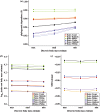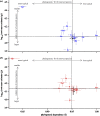The evolution of sexual dimorphism in New Zealand giant moa (Dinornis) and other ratites
- PMID: 23576789
- PMCID: PMC3652460
- DOI: 10.1098/rspb.2013.0401
The evolution of sexual dimorphism in New Zealand giant moa (Dinornis) and other ratites
Abstract
The extinct giant moa Dinornis is one of the most remarkable known examples of reversed sexual size dimorphism (RSD), with males weighing 34-85 kg, but females weighing up to 240 kg. However, there has been little consideration of the evolutionary mechanism that produced this level of dimorphism, and most living palaeognaths also exhibit varying levels of RSD. Using male and female body mass data for extant ratites and tinamous and four extinct moa genera, and tests of phylogenetic dependence (λ) of body size evolution among these species, we investigated whether Dinornis was truly unusual with respect to RSD relative to other palaeognaths, which sex was under greater pressure to change in size over evolutionary time, and which candidate hypotheses explaining the presence and variability of RSD in the genus are most plausible. We demonstrate that the extreme level of RSD exhibited by Dinornis represents a straightforward consequence of positive allometric scaling of body size. However, Dinornis females have undergone more evolutionary change than males, and larger females from high-productivity environments are associated with greater differentiation, possibly driven by intraspecific competition and female-biased selection for increased offspring investment.
Figures





Similar articles
-
Extreme reversed sexual size dimorphism in the extinct New Zealand moa Dinornis.Nature. 2003 Sep 11;425(6954):172-5. doi: 10.1038/nature01871. Nature. 2003. PMID: 12968178
-
Nuclear DNA sequences detect species limits in ancient moa.Nature. 2003 Sep 11;425(6954):175-8. doi: 10.1038/nature01838. Nature. 2003. PMID: 12968179
-
Ancient DNA reveals extreme egg morphology and nesting behavior in New Zealand's extinct moa.Proc Natl Acad Sci U S A. 2010 Sep 14;107(37):16201-6. doi: 10.1073/pnas.0914096107. Epub 2010 Aug 30. Proc Natl Acad Sci U S A. 2010. PMID: 20805485 Free PMC article.
-
Moa's Ark or volant ghosts of Gondwana? Insights from nineteen years of ancient DNA research on the extinct moa (Aves: Dinornithiformes) of New Zealand.Ann Anat. 2012 Jan 20;194(1):36-51. doi: 10.1016/j.aanat.2011.04.002. Epub 2011 Apr 28. Ann Anat. 2012. PMID: 21596537 Review.
-
Sexual dimorphism in primate evolution.Am J Phys Anthropol. 2001;Suppl 33:25-53. doi: 10.1002/ajpa.10011.abs. Am J Phys Anthropol. 2001. PMID: 11786990 Review.
Cited by
-
Intraspecific variation and directional casque asymmetry in adult southern cassowaries (Casuarius casuarius).J Anat. 2022 Oct;241(4):951-965. doi: 10.1111/joa.13733. Epub 2022 Aug 7. J Anat. 2022. PMID: 35933695 Free PMC article.
-
Femora from an exceptionally large population of coeval ornithomimosaurs yield evidence of sexual dimorphism in extinct theropod dinosaurs.Elife. 2023 Jun 13;12:e83413. doi: 10.7554/eLife.83413. Elife. 2023. PMID: 37309177 Free PMC article.
-
A nuclear genome assembly of an extinct flightless bird, the little bush moa.Sci Adv. 2024 May 24;10(21):eadj6823. doi: 10.1126/sciadv.adj6823. Epub 2024 May 23. Sci Adv. 2024. PMID: 38781323 Free PMC article.
-
Evolutionary dynamics of sexual size dimorphism in non-volant mammals following their independent colonization of Madagascar.Sci Rep. 2019 Feb 5;9(1):1454. doi: 10.1038/s41598-018-36246-x. Sci Rep. 2019. PMID: 30723219 Free PMC article.
-
The moa footprints from the Pliocene - early Pleistocene of Kyeburn, Otago, New Zealand.J R Soc N Z. 2023 Nov 14;54(5):620-642. doi: 10.1080/03036758.2023.2264789. eCollection 2024. J R Soc N Z. 2023. PMID: 39440283 Free PMC article.
References
-
- Székely T, Lislevand T, Figuerola J. 2007. Sexual size dimorphism in birds. In Sex, size and gender roles: evolutionary studies of sexual size dimorphism (eds Fairbairn DJ, Blanckenhorn WU, Székely T.), pp. 27–37 Oxford, UK: Oxford University Press
-
- Darwin C. 1871. The descent of man and selection in relation to sex. London, UK: Murray
-
- Fairbairn DJ. 1997. Allometry for sexual size dimorphism: pattern and process in the coevolution of body size in males and females. Ann. Rev. Ecol. Syst. 28, 659–68710.1146/annurev.ecolsys.28.1.659 (doi:10.1146/annurev.ecolsys.28.1.659) - DOI - DOI
-
- Amadon D. 1977. Further comments on sexual size dimorphism in birds. Wilson Bull. 89, 619–620
-
- Mueller HC, Meyer K. 1985. The evolution of reversed sexual dimorphism in size: a comparative analysis of the Falconiformes of the Western Palearctic. Curr. Ornithol. 2, 65–10110.1007/978-1-4613-2385-3_2 (doi:10.1007/978-1-4613-2385-3_2) - DOI - DOI
Publication types
MeSH terms
LinkOut - more resources
Full Text Sources
Other Literature Sources

